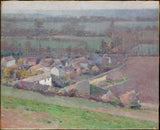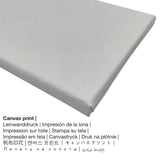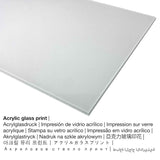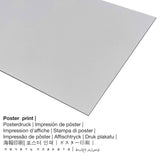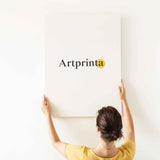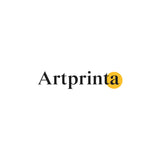Theodore Robinson, 1889 - Nlele anya nnụnụ - mbipụta nka mara mma
Ụtụ gụnyere. Mbupu gbakọrọ na ndenye ọpụpụ.
Họrọ ihe ị ga-achọ idobe n'ụlọ gị
For every product we offer different sizes & materials. You can pick your favorite size and material among the alternatives:
- Mbipụta kanvas: The printed canvas, which shall not be mistaken with an artwork painted on a canvas, is a digital image applied onto cotton canvas. Canvas prints are relatively low in weight. This means, it is easy and straightforward to hang up your Canvas print without extra wall-mounts. That is why, a canvas print is suited for any type of wall.
- Mbipụta nke aluminom: An Aluminium Dibond print is a material with an impressive depth effect - for a modern look and non-reflective surface structure. A direct Direct Print on Aluminum Dibond is the excellent introduction to the sophisticated world of fine art prints with aluminum. The white & bright parts of the original artwork shimmer with a silk gloss, however without any glare. The colors are bright and luminous in the highest definition, the fine details of the print appear crisp and clear. The direct UV print on Aluminum Dibond is the most popular entry-level product and is an extremely sophisticated way to display art, since it puts all of the viewer’s focus on the whole artwork.
- Mpempe akwụkwọ (ihe kwaaji): The poster is a UV printed canvas paper with a slight texture on the surface. A poster print is best designed for placing the art copy using a special frame. Please note, that depending on the size of the poster print we add a white margin of around 2-6cm round about the artwork in order to facilitate the framing.
- Glass acrylic ebipụtara nwere mmetụta na-egbuke egbuke: A glossy print on acrylic glass, often referred to as a UV print on plexiglass, transforms your favorite original into stunning décor. With an acrylic glass fine art print contrasts plus minor details become identifiable due to the subtle gradation. Our plexiglass protects your chosen fine art print against sunlight and external influences for many more years.
Nkwupụta iwu: We try whatever we can in order to depict the products as exact as possible and to display them visually. Nevertheless, the pigments of the print products and the printing can diverge marginally from the representation on the screen. Depending on your screen settings and the nature of the surface, colors may not be printed 100% realistically. Considering that all are printed and processed by hand, there may also be minor variations in the exact position and the size of the motif.
Additional artwork information from The Metropolitan Museum of Art (© Copyright - The Metropolitan Museum of Art - Museumlọ ihe ngosi nka nke Obodo)
Theodore Robinson, although academically trained at France’s École des Beaux-Arts, became the leading American disciple of the progressive impressionist Claude Monet. Living as a close friend and neighbor of the famous painter in the artists’ colony of Giverny between 1887 and 1892, Robinson experimented with plein-air (outdoor) painting in numerous depictions of that bucolic village, such as this work.
Product ọmụma
In 1889 onye na-ese ihe Theodore Robinson created the impressionist artpiece. The 130 years old painting has the size 25 3/4 x 32 in (65,4 x 81,3 cm). Mmanụ na kwaaji was applied by the North American painter as the medium of the artwork. It is included in the The Metropolitan Museum of Art's digital art collection. The ngalaba ọha work of art is supplied with courtesy of The Metropolitan Museum of Art, New York, Gift of George A. Hearn, 1910. Creditline of the artwork: Gift of George A. Hearn, 1910. What is more, the alignment of the digital reproduction is landscape with a ratio of 1.2: 1, which implies that the length is 20% longer than the width. The painter Theodore Robinson was an artist, whose artistic style can be attributed primarily to Impressionism. The Impressionist artist lived for 44 years and was born in the year 1852 in Irasburg, Orleans county, Vermont, United States and died in 1896.
Data nka ahaziri
| Aha nka: | "A Bird's-Eye View" |
| Nhazi nka: | sere |
| Otu izugbe: | nkà nke oge a |
| oge: | 19th narị afọ |
| Afọ nka: | 1889 |
| Ogologo afọ nka nka: | 130 afọ |
| Ọkara nke ihe osise izizi: | mmanụ na kwaaji |
| Akụkụ nke ọrụ nka mbụ: | 25 3/4 x 32 inch (65,4 x 81,3 cm) |
| Egosiputara na: | Museumlọ ihe ngosi nka nke Obodo |
| Ebe ngosi nka: | New York City, New York, Njikota Obodo Amerika |
| Ibe weebụ: | Museumlọ ihe ngosi nka nke Obodo |
| Ụdị nka nka: | ngalaba ọha |
| Site n'aka: | Ụlọ ihe ngosi nka nke Metropolitan, New York, Onyinye George A. Hearn, 1910 |
| Ebe E Si Nweta: | Onyinye nke George A. Hearn, 1910 |
Nkọwa ihe ahaziri ahazi
| Nkewa ngwaahịa: | nka nka |
| Mmeputakwa: | dijitalụ mmeputakwa |
| Usoro mmepụta: | mbipụta dijitalụ (Mbipụta UV ozugbo) |
| Ihe ngosi: | emere na Germany |
| Ụdị ngwaahịa: | a na-achọ |
| Ihe eji eme atụmatụ: | foto mgbidi, ụlọ mmepụta nka nka |
| Nhazi nke ihe nka: | usoro odida obodo |
| Njikwa oyiyi: | 1.2:1- (ogologo: obosara) |
| Nkọwa: | ogologo bụ 20% ogologo karịa obosara |
| Akụrụngwa ị nwere ike ịhọrọ: | Mpempe akwụkwọ mmado (akwụkwọ kwaaji), mbipụta kanvas, mbipụta ọla (aluminium dibond), mbipụta iko acrylic (nwere ezigbo mkpuchi iko) |
| Mbipụta kanvas (akwa akwa na etiti ihe ndọtị): | 60x50cm - 24x20", 120x100cm - 47x39", 180x150cm - 71x59" |
| Mbipụta iko acrylic (nke nwere ezigbo mkpuchi iko): | 60x50cm - 24x20", 120x100cm - 47x39" |
| Mpempe akwụkwọ mmado (akwụkwọ kwaaji) nha dị iche iche: | 60x50cm - 24x20", 120x100cm - 47x39" |
| Nhọrọ Dibond (ihe alumnium) nhọrọ: | 60x50cm - 24x20", 120x100cm - 47x39" |
| Igwe onyonyo: | biko mara na ngwaahịa a enweghị etiti |
Ose okwu
| Ihe nkiri: | Theodore Robinson |
| Aha nka ndị ọzọ: | theo robinson, th. robinson, Robinson Theodore, Robinson, Theodore Robinson |
| Gender: | nwoke |
| Obodo onye nka: | American |
| Ọrụ: | onye na-ese ihe |
| Mba onye si: | United States |
| nhazi ọkwa: | omenkà nke oge a |
| styles: | Mmetụta |
| Oge ndu: | 44 afọ |
| A mụrụ: | 1852 |
| Amụrụ na (ebe): | Irasburg, Orleans County, Vermont, Njikota Obodo Amerika |
| Nwuru: | 1896 |
| Nwụrụ na (ebe): | New York City, New York State, Njikota Obodo Amerika |
Ederede a bụ ikike ọgụgụ isi ma chekwaa ya site na nwebisiinka © | www.artprinta.com (Artprinta)

